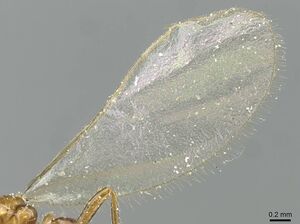Pheidole acutidens
| Pheidole acutidens | |
|---|---|

| |
| Conservation status | |
| Scientific classification | |
| Kingdom: | Animalia |
| Phylum: | Arthropoda |
| Class: | Insecta |
| Order: | Hymenoptera |
| Family: | Formicidae |
| Subfamily: | Myrmicinae |
| Tribe: | Attini |
| Genus: | Pheidole |
| Species group: | fallax |
| Species: | P. acutidens |
| Binomial name | |
| Pheidole acutidens (Santschi, 1922) | |
Pheidole acutidens is a permanent workerless parasite of Pheidole nitidula . The discoverer of this remarkable species, Carlos Bruch (1931), has provided extensive notes on its anatomy, ecology, behavior, and life cycle. (Wilson 2003)
| At a Glance | • Workerless Inquiline • Brachypterous Male |
Identification
See the description in the nomenclature section.
Keys including this Species
Distribution
Latitudinal Distribution Pattern
Latitudinal Range: -27.484417° to -35.96375°.
| North Temperate |
North Subtropical |
Tropical | South Subtropical |
South Temperate |
- Source: AntMaps
Distribution based on Regional Taxon Lists
Neotropical Region: Argentina (type locality), Brazil.
Distribution based on AntMaps
Distribution based on AntWeb specimens
Check data from AntWeb
Countries Occupied
| Number of countries occupied by this species based on AntWiki Regional Taxon Lists. In general, fewer countries occupied indicates a narrower range, while more countries indicates a more widespread species. |

|
Estimated Abundance
| Relative abundance based on number of AntMaps records per species (this species within the purple bar). Fewer records (to the left) indicates a less abundant/encountered species while more records (to the right) indicates more abundant/encountered species. |

|
Biology
Castes
Queen
Images from AntWeb

| |
| Syntype of Pheidole acutidens. Queen (alate/dealate). Specimen code casent0913258. Photographer Z. Lieberman, uploaded by California Academy of Sciences. | Owned by NHMB, Basel, Switzerland. |
Nomenclature
The following information is derived from Barry Bolton's Online Catalogue of the Ants of the World.
- acutidens. Bruchomyrma acutidens Santschi, 1922d: 249, figs. A-D (q.) ARGENTINA. Bruch, 1931: 31 (m.). Combination in Pheidole: Wilson, 1984: 327. See also: Wheeler, W.M. 1937c: 52; Wilson, 2003: 260.
Unless otherwise noted the text for the remainder of this section is reported from the publication that includes the original description.
Description
From Wilson (2003): An extreme workerless social parasite of Pheidole nitidula, with adaptations that make it unique within the genus.
Queen: with 9- to 11-segmented antennae and minute, falcate toothless mandibles that taper to needle-sharp points.
Male: pupiform, with mandibles vestigial or absent.
MEASUREMENTS (mm) Syntype queen: HW 0.40, HL 0.42, SL 0.72, EL 0.12, PW 0.58.
COLOR Queen: yellowish brown.
Figure. Queen. Scale bars = 1 mm.
Type Material
ARGENTINA: La Plata, Buenos Aires, col. Carlos Bruch. Type locality: Alta Gracia (La Granja). Sierra de Córdoba, Argentina. Naturhistorisches Museum, Basel - as reported in Wilson (2003)
Etymology
L acutidens, sharp-pointed tooth apparently referring to the reduced, acute mandible. (Wilson 2003)
References
- Ferreira, A.C., M.F.O. Martins, and R.M. Feitosa 2016. Rediscovery of the morphologically remarkable social parasite Pheidole acutidens (Santschi, 1922), with the first records for Brazil. Sociobiology 63(4):1069-1072.
- Wilson, E. O. 2003. Pheidole in the New World: A dominant, hyperdiverse ant genus. Harvard University Press, Cambridge, MA. (page 260, fig. queen described)
- Bruch, C. 1931. Notas biológicas y sistemáticas acerca de Bruchomyrma acutidens Santschi. Rev. Mus. La Plata 33: 31-55. (page 31, male described)
- Casadei-Ferreira, A., Economo, E.P., Feitosa, R.M. 2020. Additions to the taxonomy of Pheidole (Hymenoptera: Formicidae) from the southern grasslands of Brazil. Revista Brasileira de Entomologia 64(4):e20200068 (doi:10.1590/1806-9665-RBENT-2020-0068).
- de la Mora, A., Sankovitz, M., Purcell, J. 2020. Ants (Hymenoptera: Formicidae) as host and intruder: recent advances and future directions in the study of exploitative strategies. Myrmecological News 30: 53-71 (doi:10.25849/MYRMECOL.NEWS_030:053).
- Ferreira, A., Martins, M., Feitosa, R. 2016. Rediscovery of the morphologically remarkable social parasite Pheidole acutidens (Bruch), with the first records for Brazil. Sociobiology 63, 1069. (doi:10.13102/sociobiology.v63i4.1263).
- Santschi, F. 1922e. Description de nouvelles fourmis de l'Argentine et pays limitrophes. An. Soc. Cient. Argent. 94: 241-262 (page 249, figs. A-D queen described)
- Wheeler, W. M. 1937c. Mosaics and other anomalies among ants. Cambridge, Mass.: Harvard University Press, 95 pp. (page 52, see also)
- Wilson, E. O. 1984b. Tropical social parasites in the ant genus Pheidole, with an analysis of the anatomical parasitic syndrome (Hymenoptera: Formicidae). Insectes Soc. 31: 316-334 (page 327, Combination in Pheidole)
References based on Global Ant Biodiversity Informatics
- Kempf, W.W. 1972. Catalago abreviado das formigas da regiao Neotropical (Hym. Formicidae) Studia Entomologica 15(1-4).
- Pages using DynamicPageList3 parser function
- IUCN Red List vulnerable species
- Ant Associate
- Host of Pheidole nitidula
- Workerless Inquiline
- Brachypterous Male
- South subtropical
- South temperate
- Species
- Extant species
- Formicidae
- Myrmicinae
- Attini
- Pheidole
- Pheidole acutidens
- Myrmicinae species
- Attini species
- Pheidole species
- Ssr
- IUCN Red List




